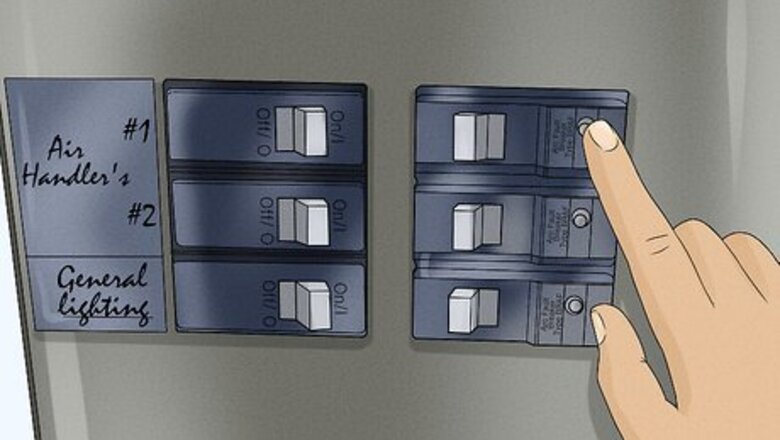
views

Determine the structure type. If circuits are installed in a space for use other than a dwelling unit, AFCI is not required (commercial and industrial spaces are not required to have AFCI protection). AFCI protection is required only in dwelling units (apartments, homes, manufactured homes and mobile homes), in "dormitory units" and in hotel/motel guest rooms. Historically, electrical fires in branch circuit wiring accounted for nearly one third of the fires in dwellings in the USA.

Identify voltage, current and circuit destinations. "All 120 volt, single-phase, 15- or 20-amp branch circuits supplying outlets [includes both lighting outlets and receptacle outlets] and devices [including switches] installed in dwelling unit kitchens, family rooms, dining rooms, living rooms, parlors, libraries, dens, bedrooms, sunrooms, recreation rooms, closets, hallways, laundry rooms, or similar rooms or areas shall be protected" by a listed arc fault circuit interrupter, with limited exceptions, as noted below. This means that nearly every habitable space in new homes, other than listed below, are required to have this protection. Any existing circuits that are modified, replaced or extended in or into those area are also required to have AFCI protection installed, if they extend it by more than six (6) feet or add an outlet or device. When an existing receptacle outlet is replaced on a branch now required to have AFCI protection, it shall be provided with AFCI protection. All 120-volt, single-phase, 15- and 20-ampere branch circuits supplying outlets installed in dormitory unit bedrooms, living rooms, hallways, closets, bathrooms and similar rooms shall be protected" by AFCI devices. Circuits that provide more than 20 amps or more than 120 volts (208 / 240 volts circuits) are also exempted from AFCI protection. That means all double-pole (208 or 240 volt) appliances such as: electric ranges, water heaters, clothes dryers, permanently installed electric heaters (baseboard and blower types), artesian well pumps, etc. are exempt as are those that require a single pole circuit breaker greater than 20 amps. Note that if a "permanently installed electric heater" is supplied by 120 volts on a 15- or 20-Amp circuit, it would not be exempt from AFCI protection, under this rule. Circuits supplying less than 120 volts (e.g., 24-volt control wiring, 12-volt lighting, telephone- or TV-signal wiring) are also exempt from AFCI protection.

Determine if a location or type-specific exemption applies. Absent from the list of spaces that require AFCI protection are: bathrooms, outdoors, unfinished basements, crawl spaces, attics and garage spaces, to name a few. Kitchens and laundry areas of manufactured or mobile homes are no longer exempt. Additional AFCI considerations apply to solar-power systems and power-grid interconnection systems. Some heat and smoke alarm systems are prohibited from being connected to GFCI or AFCI circuits. An exception for AFCI may apply where permitted by code, such as when using certain metallic wiring methods. The "National Fire Alarm Code" does not exempt "smoke alarms", but does require "a secondary power source" for smoke alarms powered by circuits protected by GFCI or AFCI devices. Locally adopted codes may differ.

Choose a method of providing protection. AFCI protection is provided by either an AFCI circuit breaker installed at the electrical panel, or by a receptacle specifically identified as providing arc fault protection. Both the circuit breaker and receptacle are installed similar to the GFCI circuit breakers and receptacles that are present in many homes already. The circuit breaker method protects the entire circuit, while the receptacle protects only from the point of installation on the circuit, to the end of the circuit. A caveat for the receptacle method is that it is only considered meeting the code requirements if the portion of the circuit between the electrical panel and the AFCI receptacle is installed in pipe or armored cable and all boxes in the circuit must be metal (the common practice of using plastic / fiber boxes or romex cables would prohibit this solution). Some appliances are also required to have their own integral AFCI or GFCI protection, including air conditioners, refrigerators, freezers, water coolers and beverage dispensers.

Provide both AFCI and GFCI protection where required. Any required GFCI protected receptacle(s) that are installed in a location that additionally requires AFCI protection (see list above), will have to be AFCI protected as well. It is possible to install an AFCI receptacle on a circuit protected by GFCI circuit breaker to satisfy the requirement but only if at least the portion of the circuit between the panel and the AFCI receptacle is installed in metallic pipe or metal-armored cable and all boxes in the circuit must be metal (the common practice of using plastic / fiber boxes or Romex® cable would prohibit this solution). In this case, install an AFCI circuit breaker and a GFCI receptacle. The pipe, armored cable, metal box, etc. limitations on AFCI receptacles are not applicable to GFCI receptacles. Some manufacturers offer circuit breakers that provide both AFCI and GFCI protection in a single package.

Add AFCI protection voluntarily. Existing installations are not required to upgrade to AFCI protection. In other words, homes built prior to the first effective date of bedroom AFCI requirements (in 2002) are not required to have any AFCI devices. In homes without AFCI devices in the locations required by the current code, the ultimate protection would be to provide AFCI protection throughout the dwelling (except for circuits that have problems with AFCI). Replace all existing single pole 15 and 20 amp circuit breakers (and any double pole 15 and 20 amp circuit breakers that supply circuits with shared neutrals that provide two 120 volt circuits), or replace the first receptacle on a circuit to an AFCI type to add this protection. Use AFCI circuit breakers to add arc fault protection to the entire length of existing circuits. This is simply a matter of locating the circuit's hot wires (black, red or blue that are connected to the circuit breaker) and the circuit's neutral (white) wire and replacing the circuit breaker in the panel with the AFCI type. AFCI breakers, like the GFCI counterparts, have a coiled neutral wire that must be connected to the electric panel's neutral bus. The hot and neutral circuit wires will all connect directly to the AFCI circuit breaker, and protects the entire circuit from arc faults. Use AFCI receptacles to provide protection to the circuit only from the point at which the receptacle is installed. Replace the first non-GFCI receptacle in the circuit with the AFCI receptacle and connect the wires from the panel to the LINE terminals and the wires that continue to the rest of the circuit to the LOAD terminals. Depending on wiring methods used during construction, this method may not satisfy the requirements of the code. The AFCI receptacles were much more popular prior to 2005 code, when this protection was required only in bedrooms. Since then, the code expanded the requirement to include significantly more locations in the dwelling, it seems that manufacturers have begun to produce the circuit breaker instead. As a result, AFCI receptacles may be more difficult to obtain.















Comments
0 comment